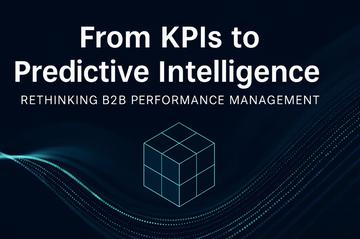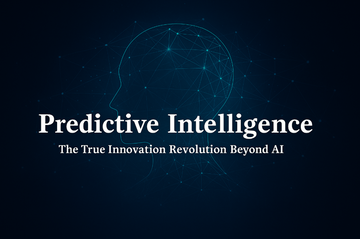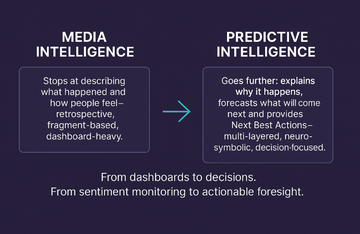From KPIs to Predictive Intelligence: Rethinking B2B Performance Management
by Uwe Seebacher on Sep 18, 2025

By Prof. Dr. Uwe Seebacher
Structural and Methods Scientist | International Faculty | Thought Leader on Predictive Strategy and Post-Growth Transformation
Introduction
For years, business leaders have relied on dashboards and KPIs to measure and steer performance. Click-through rates, cost-per-click, impressions, and conversion metrics dominate the way marketing and sales teams report success. At first glance, this seems perfectly logical: if something can be measured, it can be managed.
But the reality in today’s complex B2B environments tells a different story. Companies are drowning in numbers yet starving for direction. Dashboards are getting bigger, not smarter. And while managers are surrounded by data, they often feel less confident when it comes to making decisions.
This article takes a closer look at the paradox of performance measurement in B2B marketing. It explores why traditional KPIs are insufficient, how KPI inflation leads to dashboard fatigue, and why more data does not necessarily mean better management. Most importantly, it outlines how Predictive Intelligence (PI) can move us beyond the age of dashboards into an era of clarity, action, and measurable business impact.
The Problem with Traditional KPIs
The first wave of digital marketing measurement was built on vanity metrics. Cost-per-click (CPC) and click-through rates (CTR) became the default measures of success. They are simple, easy to collect, and intuitively understandable. But they tell us very little about the actual value being created in B2B.
In consumer markets, where buying decisions are often impulsive, such metrics might provide a rough indicator of effectiveness. In B2B, with long buying cycles, multiple decision-makers, and high investment volumes, they remain surface-level indicators at best. A low CPC may look impressive, but if the leads generated are irrelevant or unqualified, the apparent efficiency quickly turns into wasted sales resources and missed opportunities.
This creates a dangerous illusion: marketing looks successful on paper, while the business impact is negligible. The more teams chase easy-to-reach vanity metrics, the further they drift from genuine value creation.
KPI Inflation: When Measurement Becomes Noise
As organizations mature, they often add more KPIs in an attempt to capture complexity. Every department wants its perspective reflected, every manager demands visibility, and every campaign adds a new set of metrics. The result is KPI inflation.
Dashboards swell with dozens—sometimes hundreds—of indicators. Yet, as with overfitting in machine learning, the system becomes too complex to generalize. Leaders end up staring at conflicting signals. One KPI suggests success, another hints at failure. Which one should they trust?
Instead of empowering decision-making, KPI inflation paralyzes it. Meetings turn into debates over data rather than discussions about action. Leaders postpone decisions because they cannot find a clear signal in the noise. The system designed to bring clarity ends up creating confusion.
This is what I call the decision vacuum: a state where the abundance of information overwhelms the ability to act.
Beyond Output: The Missing Dimensions
The fundamental flaw of traditional KPIs is that they measure output, not process or quality.
-
CPC and CTR measure how many people clicked on an ad, but not whether the right people did.
-
Lead numbers show how many contacts were generated, but not how fast or effectively they are being nurtured.
-
Revenue reports tell us what was closed, but not whether the process was efficient or sustainable.
What’s missing are throughput and quality metrics:
-
How quickly do leads move through the funnel (funnel velocity)?
-
How fast does a customer reach value after the first touchpoint (time-to-value)?
-
How stable and predictable are conversion patterns across different customer segments?
These are the indicators that determine whether a B2B marketing system is not only producing results but producing them effectively and sustainably. Without them, performance management remains a game of surface impressions.
The Psychology of Dashboard Fatigue
There is also a human dimension to this challenge. Cognitive psychology shows us that decision quality deteriorates when people are exposed to too much information. This is known as information overload and decision fatigue.
Leaders have limited cognitive capacity. When every dashboard meeting confronts them with dozens of metrics, charts, and benchmarks, they eventually stop processing meaningfully. They either revert to intuition, pick the metric that confirms their bias, or defer decisions altogether.
In practice, this means the dashboards we designed to make decisions easier are often doing the opposite. The problem isn’t the lack of data—it’s the inability to translate that data into clear, prioritized actions.
A Mathematical Lens: The Inverted U-Curve
We can describe this paradox with a simple model. Imagine a function that measures the utility of information. At first, every additional data point adds value. The curve rises steeply. But over time, the incremental benefit decreases. Eventually, costs—cognitive effort, time, organizational friction—grow faster than the benefits.
The result is an inverted U-curve. On the left, too little information leads to poor decisions. On the right, too much information leads to confusion. The optimal point—the “sweet spot”—lies in the middle, where the marginal benefit of information equals the marginal cost.
In real organizations, most leaders are no longer on the left side of the curve. They are far on the right, drowning in dashboards and reports, far beyond the point of optimal utility.
The Promise of Predictive Intelligence
So how can we move back toward clarity? The answer is not “more dashboards” or “better KPIs.” It is a different paradigm altogether: Predictive Intelligence (PI).
Predictive Intelligence builds on the foundation of Business Intelligence but goes further. Instead of showing what happened in the past, PI forecasts what is likely to happen next—and, crucially, recommends what to do about it.
Examples in B2B marketing include:
-
Predicting which leads are most likely to convert, so sales can focus resources.
-
Forecasting churn risk before customers leave, enabling proactive retention strategies.
-
Dynamically reallocating budgets toward channels with the highest expected ROI.
-
Suggesting the next best action for each customer interaction based on behavior patterns.
The real advantage is not the prediction itself—it’s the translation of complexity into action. PI filters out noise, reduces cognitive load, and shifts leadership from debating dashboards to executing decisions.
Moving from Data to Action
This is the crucial paradigm shift: from data to action.
Dashboards and KPIs deliver information. Predictive Intelligence delivers direction. Instead of forcing leaders to interpret dozens of metrics, PI systems highlight the two or three actions that will most likely create impact.
This not only accelerates decision-making but also increases decision confidence. Leaders no longer feel trapped in the decision vacuum. They have a clear path forward, supported by evidence.
A New Balanced Scorecard for B2B Marketing
To operationalize this shift, we need a new way to think about performance management in B2B. Traditional balanced scorecards emphasized finance, customers, internal processes, and learning. A B2B Marketing Balanced Scorecard for the future should integrate:
-
Actionability: Metrics that lead directly to decisions, not just reporting.
-
Process Velocity: How fast and efficiently value is created.
-
Predictive Value: Indicators that anticipate outcomes, not just describe history.
-
Quality & Ethics: Measures of trust, compliance, and customer experience.
This new scorecard moves beyond the illusion of control created by vanity metrics and anchors performance management in what truly drives business success.

Fig. 1: The new B2B Marketing Balance Scorecard (Source: own illustration)
The Future: From Dashboards to Decision Systems
The era of dashboard obsession is ending. Leaders are realizing that the problem is not the lack of data but the lack of translation into action. The future belongs to decision systems that integrate data, models, and intelligence to recommend and prioritize actions in real time.
Predictive Intelligence is not a futuristic concept. It is already here, reshaping how companies allocate resources, design campaigns, and engage with customers. What differentiates successful organizations from the rest is not how much data they have, but how effectively they transform that data into action.

Fig. 2: B2B Marketing Balance Scorecard (Source: own illustration)
Conclusion
The history of management has always been about turning complexity into clarity. Spreadsheets replaced gut feeling. Dashboards replaced static reports. And now, Predictive Intelligence is set to replace the dashboard era.
The central insight is simple: measuring more does not mean managing better. The real progress lies in knowing which metrics matter, when enough data is truly enough, and how to convert insights into action with speed and confidence.
B2B organizations that embrace Predictive Intelligence will not just manage performance—they will unlock new levels of agility, efficiency, and growth. Those that cling to dashboards risk being left behind in the decision vacuum of KPI inflation.
The choice is clear: the future of performance management is not about data abundance, but about intelligent action.
If you want to get the entire German article, please write to to hello(a)aqps.eu and we will send you the article for free.




